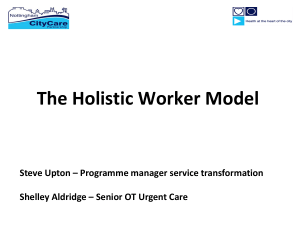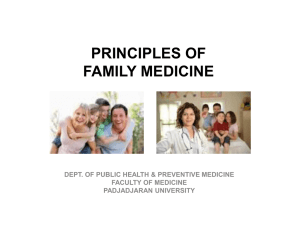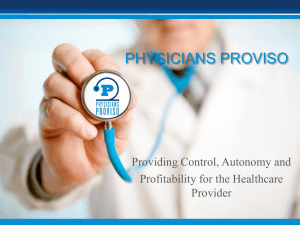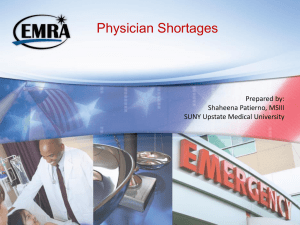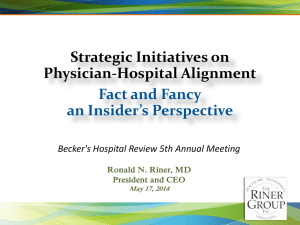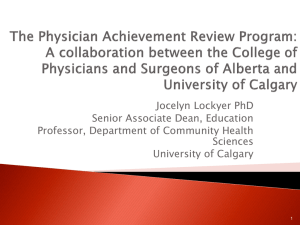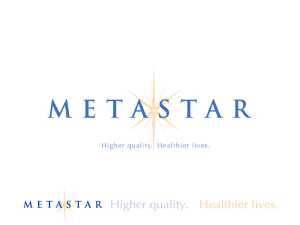Effective communication with families of patients
advertisement
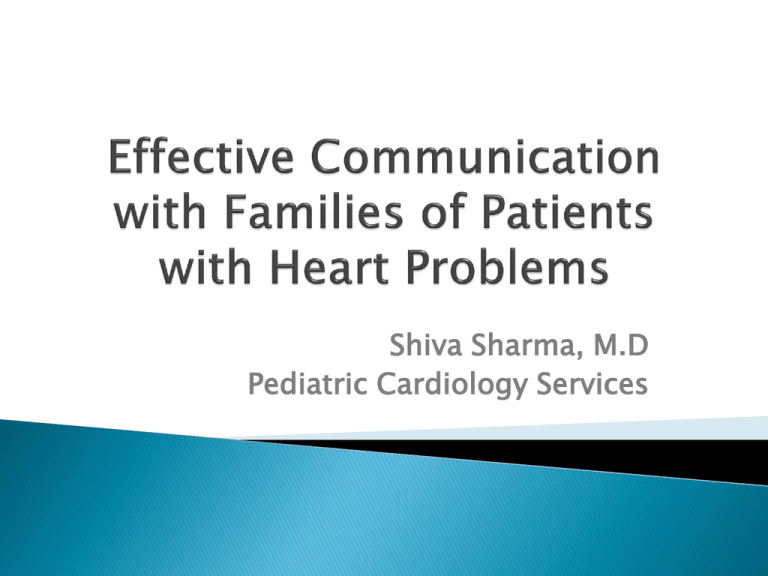
Shiva Sharma, M.D Pediatric Cardiology Services Extensive data has linked effective physician-patient communication to biological, psychological, social, and legal outcomes of care. It has been tied to better adherence, shorter hospital stays, better efficiency and cost effectiveness, less malpractice, and not surprisingly, increased physician and patient satisfaction Case presentations followed by discussion of effective communication skills Work up to more complex scenarios: bad news/difficult situations and conversations Prenatal Counseling Medical error disclosure Enhancement of quality of care Increasing satisfaction Patient/Caregivers Promoting excellence in physicians RH, 10 yr WM F Hx of hyperchol.; Dad MI at 35 yrs Sedentary, obese, male, Mod.⇧ LDL, ⇩HDL TLC program initiated. 2nd visit 10% ↓ in LDL,TG with TLC ; ⇪Wt. Extended meeting with Dad and RH to understand their perspective, rationalize care, and elicit their partnership Habit 1: Invest in the Beginning Habit 2: Elicit the Patient's Perspective Habit 3: Demonstrate Empathy ◦ "... to know and understand, obviously is a dimension of being scientific; ... to feel known and understood, is a dimension of caring and being cared for.“ Habit 4: Invest in the End Establish rapport & build trust rapidly Facilitate effective info. exchange Demonstrate caring &concern Increase adherence to plan Improve health outcomes 120-160,000 interviews in a lifetime. Modest improvement in delivery of care can improve outcomes , satisfaction and cost. Reflection--"I can see that you are ... " Legitimation--"I can understand why you feel ... " Support--"I want to help." Partnership--"Let's work together ... " Respect--"You're doing great." Listening Partnership Patient Empathy Individualization Conveying bad news and engaging in difficult conversations with patients and their families are pivotally important, although anxiety-provoking components of clinical practice: “Clinicians may fear they will not be able to find the “right words” They will say too much, too little, or the wrong thing altogether. Further, clinicians worry that imparting difficult news may diminish hope, compound a family’s suffering, or unleash emotional responses” WT, 15yr, AA male Exertional chest Pain Abnomal EKG with T wave inversion Echo Confirmed IHSS Family conference What do patients want to know? How do patients experience bad news? How competent are physicians in giving bad news? How should physicians give bad news? Does how bad news is given make a difference? Do cultural differences matter? 2,331 patients at UK cancer centers: –98% wanted to know if the illness was cancer –87% patients preferred “as much information as possible” Need to individualize delivery to patient needs Jenkins, Br J Cancer 2001;84:48-51 Bad news results in a cognitive, behavioral, or emotional deficit in the person receiving the news that persists Clinicians can’t change the news Clinicians can make the news worse, or they can help give realistic hopes 100 patients diagnosed with cancer: – Shock 54% – Fright 46% – Accept 40% – Sadness 24% – Not worried 15% Lobb, Med J Aust 1999: 290-4 Three months after parents received bad news 12 of 23 sets took in “little or none of the information given” 4 of 23 sets denied that a separate information session had occurred 10 of 19 sets remembered the information session, but didn’t understand the content Eden, Pall Med 1994: 105114 Technical language frequently unclear 100 women with breast cancer: ◦ 73% misunderstood “median survival” ◦ No agreement on what a “good” chance of survival meant numerically Ford, Soc Sci Med 1996: 1511-9 5 oncologists studied intensively None predicted patient distress better than chance One had negative predictive behavior All very satisfied with their performance Little probing about patient emotional state Clinician Patient Stress Encounter Time Ptacek, JAMA 1996: 496-502 Physicians may feel discomfort with the intense emotions displayed by parents in response to the news, such as sadness, anger, and blame. Physicians may feel guilty or inadequate regarding their inability to cure the child. When the child’s illness is sudden, little opportunity may exist to establish relationships with parents before communicating bad news, thus making it hard to anticipate parents’ informational and emotional needs. S - ‘‘setting up the interview.’’ This portion of the protocol recommends a mental rehearsal for physicians before delivering the news P – “assessing the patient’s perception.’’ This portion of the protocol encourages the physician to use open-ended question to assess how much the patient/parent knows before breaking the news. I – “obtaining the patient’s invitation.’’ This step involves asking the patient/parent at the time of testing how they would like the results to be explained. K – ‘‘giving knowledge and information to the patient.’’ E - ‘‘addressing the patient’s emotions with empathetic responses.’’ S- ‘‘strategy and summary.’’ As prospective parents, when you learn your baby has a congenital heart defect, the news can be devastating. Feelings of helplessness, confusion, fear and mourning over the loss of a healthy baby occur. In addition, extremely difficult and life changing discussions and decisions need to take place in a relatively short period of time. MJ is a 25 yr WF. 18 wks gestation fetus found to have CHD and told about it. Fetal echo: HLHS confirmed with MA and AA Extended Family conference with Mom and Dad. Earlier studies have reported: • Increased maternal anxiety with prenatal diagnosis of any fetal anomaly (Detraux et al,1998) • Considerable psychological distress in mothers(as compared to fathers) which may be markedly underestimated by healthcare providers (Leithner et al, 2004). This may require professional help in the perinatal period. (Skari et al, 2006) • Help families cope with the news of CHD Help families understand prognosis/diagnosis. Make transition to post natal life as seamless as possible • • • • • Try not to overwhelm the parents Challenge to provide the information in a way that is easily understood Only a small fraction of what is said is likely to be retained Typically go through normal anatomy and physiology and then go through the defect Benefit of multi-disciplinary approach Respect for patient autonomy is a cornerstone of the Codes of Medical Ethics of the American Medical Association (AMA) and encompasses the rights of patients to receive all information necessary to make informed and educated decisions about their care. Disclosure of adverse events is implicit in this principle, because without it patients are not fully informed. Failure to disclose threatens the trust inherent in a doctor–patient relationship. Research on patients, family members, and attorneys suggests that patients are less likely to sue if disclosure has taken place What do patients actually expect after an injurious medical error has occurred? Numerous studies in adults have examined this question, and five key messages have emerged. Patients want: ◦ ◦ ◦ ◦ ◦ An explicit statement that an error occurred To be told what the error was To be told why the error occurred To know what will be done to prevent recurrences An apology Why disclose? ◦ To preserve patient autonomy and patient-physician trust ◦ Because ethically it is the right thing to do Who should disclose? ◦ Health care worker with whom the patient has a trusting relationship, usually the responsible physician ◦ Others involved in the incident (eg, nurse, pharmacist may be included) ◦ If the physician cannot disclose, another health care worker with an established relationship with the patient or a member of the hospital leadership or quality and safety program should do the disclosure. ◦ A senior hospital administrator may need to be involved in serious cases. ◦ The patient’s primary nurse should be included in the discussions to be able to support the patient after the disclosure has occurred. To whom should the communication be made? ◦ To the patient ◦ If this is not possible, to family members or substitute decision makers What types of events should be communicated? ◦ Any incident that has resulted in harm to the patient ◦ Other incidents at the discretion of the responsible physician What information should be communicated? ◦ Acknowledge that the event occurred and give the facts. ◦ Take responsibility and apologize. ◦ Commit to finding out why. ◦ Explain what impact the event will have on the patient now and in the future. ◦ Describe steps being taken to mitigate the effects of the injury. ◦ Describe steps being taken to prevent a recurrence. When should communication take place? ◦ As soon as the event is recognized and the patient is physically and emotionally capable ◦ Ideally within 24 hours after the event is recognized Where should the communication take place? ◦ In a private and quiet area Normality Certainty Health information Partnership Delivery of information Levels of support Relationship with the caregiver Management of events Verbal , one on one basis Nonverbal communication, eye contact Simple language at level with parents Supplemental visual, written, websites to give. Check out www.pted.com Establish rapport and trust by LISTENING to parents & patients Partner with parents Including older child in conversation Treat as individuals. Contact numbers Open access RN contact Web based support groups Other families in the area with similar diagnosis +School staff Parents want control over events Access to specialized RN, MD, CHOA type hot line. Information for school Professional competence is defined as the habitual and judicious use of communication, knowledge, technical skills, clinical reasoning, emotions, values, and reflection in daily practice for the benefit of the individual and community being served. Cognitive Core knowledge Basic communication skills Information management Applying knowledge to real-world situations Using tacit knowledge and personal experience Abstract problem-solving Self-directed acquisition of new knowledge Recognizing gaps in knowledge Generating questions Using resources (eg, published evidence, colleagues) Learning from experience Technical Physical examination skills Surgical/procedural skills Integrative Incorporating scientific, clinical, and humanistic judgment Using clinical reasoning strategies appropriately (hypotheticodeductive, pattern-recognition, elaborated knowledge) Linking basic and clinical knowledge across disciplines Managing uncertainty Context Clinical setting Use of time Relationship Communication skills Handling conflict Teamwork Teaching others (eg, patients, students, and colleagues) Affective/Moral Tolerance of ambiguity and anxiety Emotional intelligence Respect for patients Responsiveness to patients and society Caring Habits of Mind. Observations of one’s own thinking, emotions, and techniques Attentiveness Critical curiosity Recognition of and response to cognitive and emotional biases Willingness to acknowledge and correct errors Heart of medicine is patient-physician encounter to heal the whole patient PERCS (Program to Enhance Relational and Communication Skills) MD RN, MSW, Students; non-hierarchical: Promote self awareness, self assessment Quality of care depends a lot on good communication with families Good communication depends a lot on listening to our patients and showing empathy. Good listening means good care. Parents are not looking for how much you know but how much do you care. Report of the Pew-Fetzer Task Force on Advancing Psychosocial Health Education • • • • • Reflection--"I can see that you are ... " Legitimation--"I can understand why you feel ... " Support--"I want to help." Partnership--"Let's work together ... " Respect--"You're doing great." Cohen-Cole SA, Bird J. Building rapport and responding to patient's emotions. In: Cohen-Cole SA. The medical interview: the threefunction approach. St Louis, MO: Mosby Year Book; 1991. p. 21-7. 1. Best practices for: a) information delivery b) management of parental anxieties & expectations c) communication of rare conditions ( the unknowns) d) communication of bad news e) empowering families/patients 2. Pre natal Counseling 3. Team Approach: Coordinating care and support Reviewing the evidence Recommendations for clinicians Cultural considerations Prognostic uncertainty may lead to reluctance in providing information about outcomes. While bad news may be best provided in the forum of a family conference, such conferences are time-consuming and require advanced planning. Additionally, societal and family expectations that death is avoidable through advanced technology work against physicians’ credibility when discussing the inevitability of a child’s death, especially when trust has not been established. Conveying bad news and engaging in difficult conversations with patients and their families are pivotally important, although anxietyprovoking components of clinical practice: ◦ Clinicians may fear they will not be able to find the “right words” ◦ They will say too much, too little, or the wrong thing altogether. ◦ Further, clinicians worry that imparting difficult news may diminish hope, compound a family’s suffering, or unleash emotional responses


